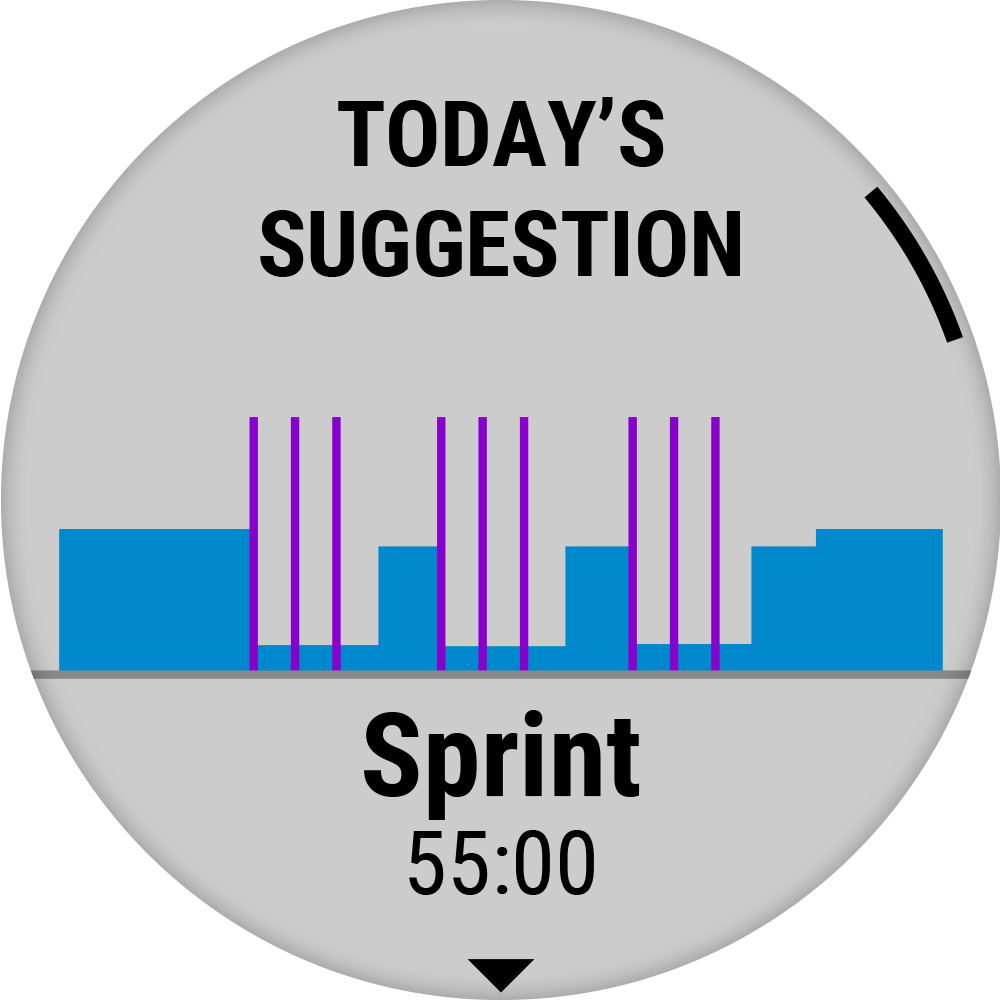
Introducing Garmin’s Daily Workout Suggestions for Runners
Runners are always in pursuit of their personal best, and Garmin’s new on-device daily workout suggestions are a great way to prepare for an upcoming race or training cycle. This new feature was first introduced on the Garmin Forerunner® 745 and aims to improve fitness levels while building a foundation for future performances.
While this article specifically talks about running with the daily suggested workout feature, cyclists can find a similar system of suggested workouts on these same watches and on the Garmin Edge® 1030 Plus. Note that you will need a power meter mounted on your bike in addition to your watch or cycling computer to utilize daily suggested workouts for cycling.
The science behind daily workout suggestions comes from the Firstbeat Analytics engine, which interprets performance data to understand the intensity and impact of your efforts. These elements are placed into the context of your current fitness level, training history and recovery state. Personalized suggestions are made with this information based on the latest sports science.
At the core of this program is a well-known and widely utilized understanding of how different workout structures stimulate and develop specific aspects of your performance.
Evenly paced runs at various intensities and durations are smartly mixed with interval-type workouts. What’s right for you today is determined by what you’ve been doing lately. Been taking some time off? Expect to find yourself working to build your endurance base right off the bat.
There are benefits to sticking with the program. Perform the daily suggested workout regularly, and you will discover a built-in periodization schedule. This means harder training weeks are mixed with more modest ones to avoid stagnation and help you shatter performance plateaus.
Training Fundamentals
Training means regularly challenging yourself with the goal of improving performance over time. It is a process of sparking physiological adaptation. Tackling varied challenges is the key to constructing a solid foundation for your performance, forging strengths and minimizing weaknesses along the way.
You can’t push yourself to the max in every direction every day and expect long-term results. Successful athletes typically concentrate on improving a single aspect of performance at a time. In the weight room, you can focus on leg strength one day and upper body strength the next. Strive to apply the same principle when you lace up your running shoes by focusing on different efforts when you hit the road.
As you discover the training run structures suggested by this program, keep in mind that categorization of workouts is based on the primary benefit or role played in your development. Below the surface, however, your physiology works across a continuum to support performance. That means, for example, that a run designed to build your anaerobic capacity can still have a significant aerobic element to it.
What Types of Runs Can You Expect?
There is a total of seven different workout structures that can be recommended. There will also be days when the best option is for you to

rest up for your next challenge. The specifics of your daily run will vary somewhat based on your situation. For example, the duration of an endurance-building run will be longer or shorter based on what you can handle today.
If you are already familiar with the Load Focus screen in the Training Status widget, you will probably notice that these runs map neatly onto the Anaerobic, Low Aerobic and High Aerobic bars that help guide your Training Load toward the right balance.
Low-intensity Aerobic Training Runs
Active “Recovery” Runs
The easiest runs you will ever do are recovery runs. Some have described the proper pace for recovery runs as “embarrassingly slow.” Performing an active recovery workout correctly and gaining the intended benefit, however, requires great discipline. It’s easy to let your intensity and speed drift upwards as you go along.
Metabolic byproducts accumulate in your muscles during harder, more-intense workouts. The goal of recovery runs is to gently increase circulation, flushing cellular waste out of your muscles in the process. Overdo it during your recovery run and you are likely adding to the problem not clearing it away. There are no rewards to be earned by pushing the limits of your recovery runs.
You are simply adding stress to your body, disrupting potential gains triggered by the other workouts in your program.
Many runners take pride in never missing their daily run. This level of commitment is key to the success of any training program. With that in mind, an often-overlooked benefit of recovery runs is that they allow you to maintain your routines without counterproductively overloading yourself.
Endurance “Base” Runs
These longer endurance-focused runs will likely represent the bulk of your low-intensity training. And like recovery runs, part of the challenge comes from keeping the intensity of your efforts low. This is particularly true if your route of choice includes uphill segments where intensity can drift up quickly.
For experienced runners, endurance-based runs may last several hours, especially when training for a marathon. The best duration for your own endurance-building runs depends on your current fitness level and will typically vary somewhere between 30 and 90 minutes.
Keeping an eye on your heart rate is the perfect way to control intensity during your run. The HR zone you work to maintain during your endurance-building runs should be adjusted to match your personal parameters. This is typically below 80% of your maximum heart rate, so it’s worth checking to make sure your HR max is set correctly for you.
Key benefits of these long, slow runs include building stronger muscles and improved running efficiency across the board. This includes your cardiorespiratory system, muscle function, metabolism and running form. Endurance runs also teach your body to burn fat better.
Enjoy getting an enormous number of strides under your belt without the strain that accumulates rapidly during higher-intensity efforts.
High-intensity Aerobic Training Runs
Tempo

Tempo runs are where things start to pick up speed and feel more like actual running. You need to put in some effort to keep up the pace but can keep going for a while if you want to go for it.
Performed at your so-called marathon pace, the target intensity for your tempo runs is sandwiched in between your endurance runs and threshold runs. These runs can be suggested as either steady-pace workouts or take the form of relatively gentle interval runs, where the harder segments are longer and performed with an intensity well below an all-out sprint.
Tempo runs are a terrific way to build general fitness and contribute nicely to the high-intensity aerobic bar on your Training Load Focus screen in the Training Status widget.
Threshold
While VO2 max defines your maximum aerobic performance capacity, your lactate threshold relates to how long you can sustain higher intensity levels relative to your maximum capacity. When the intensity of your performance exceeds your lactate threshold, fatigue accumulates quickly. Practically speaking, your lactate threshold translates into the pace or intensity that you can sustain for about 40 minutes to an hour.
If two runners have the same VO2 max, but one has a higher lactate threshold, you can expect the runner with the higher lactate threshold to win a 10K race. The runner with the higher lactate threshold should be able sustain an intensity closer to their VO2 max for a longer time.
The goal of threshold runs is to increase your lactate threshold and to do that you will need to run at or slightly above your lactate threshold pace or intensity level for an extended period. That makes for a very hard day’s run, so make sure you are up for a challenge.
“VO2 Max” or Aerobic Capacity
VO2 max-improving training runs are typically built around longer high-intensity intervals punctuated with lighter efforts that give you a chance to recover before ramping up the intensity again.
Ideally you will maintain the higher intensity level long enough for your aerobic system to catch up to the energy demand of your performance and continue for a handful of minutes. Punctuating these longer, high-intensity intervals with a chance to catch your breath ultimately allows you to run more total minutes at this level, amplifying the signal to your body that it’s time to adapt to the challenge.
The intensity of these efforts is above your lactate threshold, which means you will only be able to sustain them for a relatively short time, but the intensity is well below an all-out effort that will leave you quickly exhausted. It may take some trial and error to dial in the right level of intensity for these runs. This awareness comes with time and experience.
Anaerobic Training Runs
Anaerobic Capacity
Short, vigorous efforts are the signature of runs designed to boost your anaerobic performance capacity. The high-intensity segments of these runs, however, usually last only 40-60 seconds and are much shorter than in VO2 max training runs.
These runs are purposefully structured so that your aerobic energy system is unable to catch up to the energy demand of your performance. This forces your anaerobic energy pathways to carry the burden of synthesizing the molecular fuel (ATP) that powers your muscle contractions.
Lactic acid is a byproduct of anaerobic metabolism. It accumulates rapidly in your muscles as you power through these high-intensity interval runs. The accumulation of lactic acid is associated with various aches and often produces a burning sensation in your legs. The cool-down portion of your workout is designed to give your body a head start in the effort to clear lactic acid away from your muscles.
Sprint
The final category of training runs included in this system are built around the most explosive efforts you can perform. The extreme nature of these forces means that you can’t sustain them for very long … and that’s the point. This is your opportunity to go all out, leaving it all on the road.

Quickly summoning this amount of power from your muscles has a remarkable effect. It improves the ability of your nerves and muscles to work together. This includes developing the sequencing and coordination of muscle contractions and recruiting more muscle fiber units into the movement. These elements translate into your ability to generate higher top speeds.
These adaptations fall under the category of neuromuscular power and can have a tremendous impact on your overall performance, especially in racing and general sports performance. Working to increase top speed can also improve your race-pace running economy.
Sprint training is most beneficial when you are well rested and ready to be at your best. This means, you shouldn’t expect to see these workouts suggested if you have a significant amount of recovery time remaining due to a hard training session the day before or a bad night’s sleep.
Adequate recovery between runs is always important, but it is especially important here. Pushing your limits while fatigued opens the door to injury. It also means likely missing out on the full developmental benefit of your efforts because your body will struggle to bounce back instead of getting stronger.
Learn More
You can learn more about the science behind Garmin’s daily suggested workouts and other features by visiting the Garmin Running Science page or Firstbeat Analytics.







